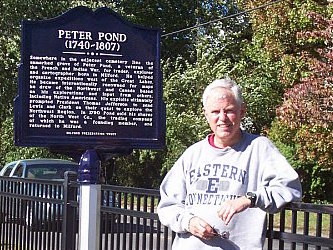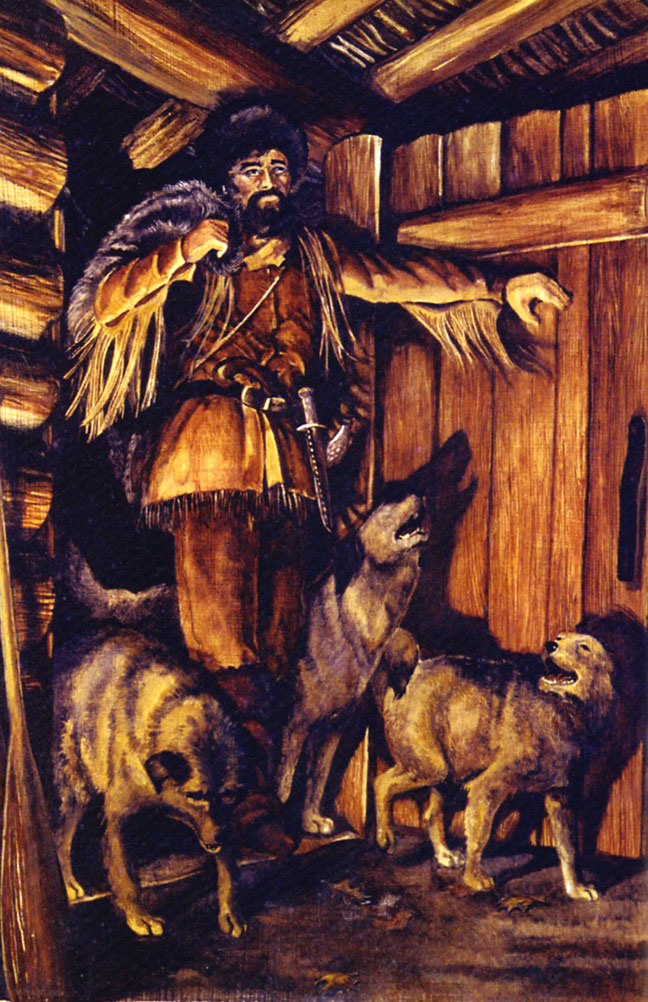Peter Pond newsletter :: NOVEMBER 2000 :: #5
MONTREAL TRIP OBSERVATIONS
I've finally been able to fight my two teenagers off to get some decent time on the computer and discuss my Montreal experience of October 27-29. Some of you might have been wondering why I didn't report back sooner.
I was 50 percent successful in seeing what I wanted to see. But what I saw was impressive. It turned out that St. Anne de Bellevue and the Fur Trade National Historic Site at Lachine were too far away and too cost-prohibitive to hire a cab. I just have to return some day with more time and my own transportation.
First, the Simon McTavish monument. I have pictures which I hope to install on the site soon. It was placed there in 1942 by the city to honor him, according to the inscription. But it was hard to find, so I thank Daniel Benjamin (Peter Pond Society member) of the National Historic Site at Lachine for his directions. It was about 20 minutes walk from the Queen Elizabeth Hotel where I stayed, straight up Peel Street to the foot of Mt. Royal Park. Go up stairs and a pathway about 100 yards and there it is by itself off to the right at the edge of the park next to the stone wall of a hospital. The rectangular stone slab is on top of a mound of earth that could have been the vault where he was before family members removed him. He was buried in 1804 near his half completed mansion which was later finished and lived in by Sir Hugh Allen. But no foundation or other evidence of a building nearby is apparent.
It is interesting that this is the only marker for this giant of the fur trade. I know Sir George Simpson, the head of Hudson Bay Company in its heyday of the mid 1800s, has a much bigger monument where he is buried in Mt. Royal Cemetery. I have seen a picture of it, but didn't get to it this day. About a block away leading down to the McGill University campus in another block is McTavish Street.
We -- my 73-year-old friend, Ed Caldwell was with me -- walked back through the stately McGill campus. The university is the result of a bequest of James McGill, a contemporary of both Pond and McTavish, who made his fortune in the fur trade and invested wisely. Apparently Peter Pond wasn't so good with his investments, for he supposedly made his own fur trade fortune but still died in poverty without a headstone. Near the front gate of the campus off the main walkway is a life-size statue of McGill in a three-corner hat and with a cane, looking like he is walking fast so as not to be late for class.
Just outside the gate and a block to the left is the McCord Museum. I saved that for Sunday morning, about a five-minute walk from the hotel, after seeing the McTavish monument Friday afternoon. The fur trade exhibit in the McCord is small but also impressive. There are portraits of all the fur trade giants: McTavish, McGill, William McGillivray (to whom Pond sold his NWC shares and who later took over the company), Charles Chaboillez, and John McDonald of Garth. What is interesting about McDonald is that he has a minor part in "The Grand Portage" as a stern taskmaster whom Daniel Harmon fears. Garth, his hometown in Scotland, was added to his name because it was the easiest way to distinguish this McDonald from so many others in the fur trade. I guess that's another reason I'm drawn to all this.
And there were four gleaming Beaver Club medals. They belonged to Hypolitte des Rivieres, Duncan McGillivray, Nicholas Montour, and McGill. On the way out through the museum's gift and book shop I added a nice volume to my fur trade library, Exploring the Fur Trade Routes of North America: Discover the Highways That Opened a Continent, by Barbara Huck (Heartland Publications, Winnipeg, 2000, $19.95 United States, $24.95 Canada). This 256-page paperback describes the rise of the fur trade in Canada, significance of more than 100 fur trade sites, and how to reach them. Needless to say, Methye Portage and the Clearwater River are included with due credit given to Peter Pond.
As for the Beaver Club Restaurant back at the QE, that was interesting too. I hemmed and hawed about eating there, but decided to go for it and enjoyed my $30 prime rib. When would there be another chance? I got to talking with the head waiter before sitting down and apparently awed him with my knowledge of the old Beaver Club. Near the front door, he lifted up the top of a glass display case decorated with old books, tomahawks and peace pipes. In one of the old books was Peter Pond's name listed among the 19 charter members of the old club. In another was the signature of a descendant, Charles Pond, who attended a 1958 meeting of people with old Beaver Club ancestry. It was the first such meeting of the modern club soon after the QE opened. Since then the club has grown to over 1,000 prominent members from around world who meet there every four months or so. Each has his own large plate with a beaver gnawing a tree at the center, and his name underneath. Some of the plates are displayed around the room. The only names I recognized were those of astronaut Alan Shepard and the late great hockey player, Maurice "Rocket" Richard. I bought a plate for $40 (no name on it, no one's asked me to join) and took home a complimentary menu.
That's pretty much what happened. If I've have created a fur trade history trail for others to follow, as some of you have suggested, so much the better.
As for the barbershop singing contest which took up most of the weekend, we finished 18th out of 20 choruses from around New England and eastern Canada. No where to go but up, eh?
This is the McTavish Monument erected in a lonely section of Mount Royal Park, one of three pictures on this site from my October 2000 weekend visit to Montreal. The circumstances of this monument may be read above in Peter Pond Society Newsletter No. 4. The rest of the inscription reads: "Sacred to the memory of Simon McTavish Esquire who died July 6th, 1804, aged 54 years. This monument is erected by his nephews William and Duncan McGillivray to commemorate their high sense of his manly virtue, and as a grateful tribute for his many acts of kindness to them. Restored by the City of Montreal 1942."
Statue of James McGill (1744-1813) on the campus of McGill University which he founded, second of three pictures on the site from my October 2000 weekend visit to Montreal. Peter Pond and McGill did business with each other and both were members of the exclusive Beaver Club. McGill's Beaver Club medal is one of four on exhibit in the McCord Museum, one block off campus. My impression of this statue is that of a student hurrying to class so as not to be late.
A plate like those used by members of the exclusive modern day Beaver Club which meets several times a year in the Queen Elizabeth Hotel, Montreal. The center is similar to the design of all club medals which were made of gold and issued as name tags to original members of the late 18th and early 19th centuries. Peter Pond was one of 19 charter members. Illustations around the edge depict early traders interacting with Indians and paddling canoes. Today, all members have their names inscribed at the bottom under 1785, the year the original club was founded. Modern day members have included Astronaut Alan Shepard and the late great hockey player, Maurice "Rocket" Richard. This is the third of three photos from my October 2000 weekend trip to Montreal. I am not a member, but was able to buy a plate for $40.
Oh, yes. The site's hits are approaching the mid 1950s. Should reach 2000 any day.

Au revoir,
Bill
website design by Daniel Ortoleva
